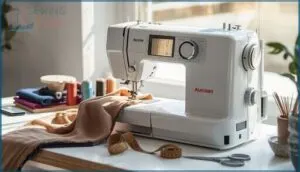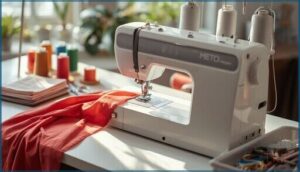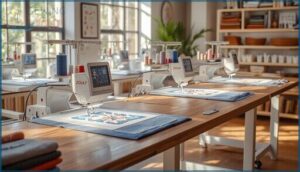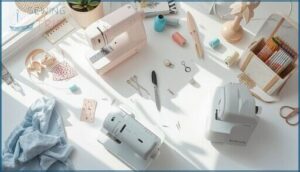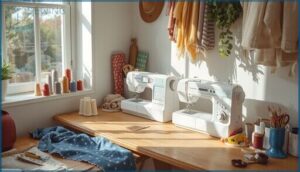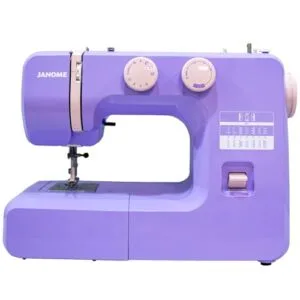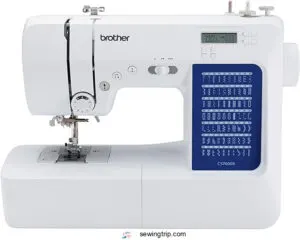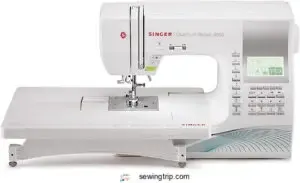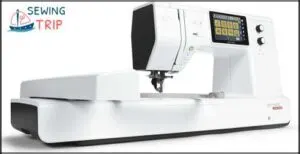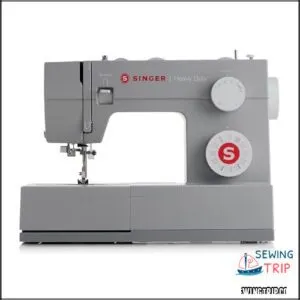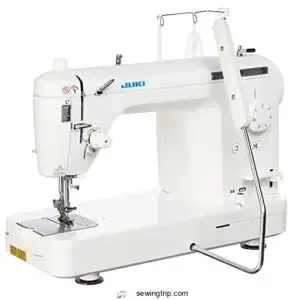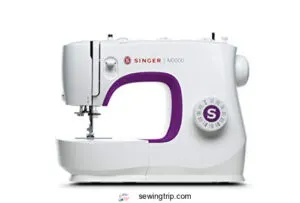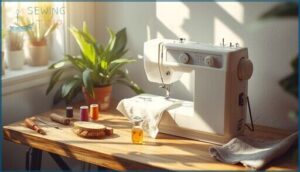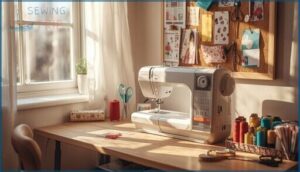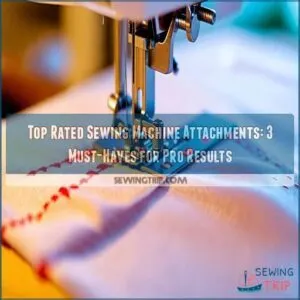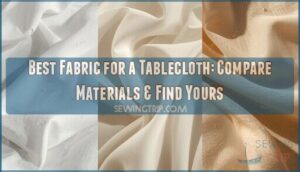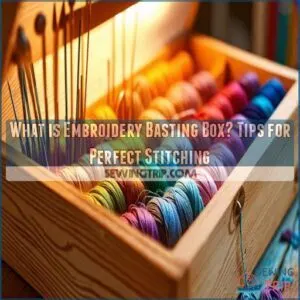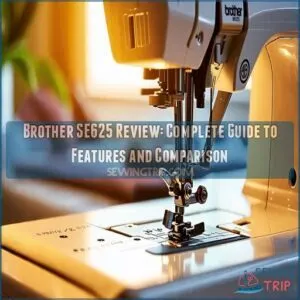This site is supported by our readers. We may earn a commission, at no cost to you, if you purchase through links.

You can spot a seasoned home sewist by their machine: not the fanciest, but the one humming steadily through denim, silk, and every project in between. The best sewing machine for home use isn’t always the priciest model with hundreds of stitches—it’s the one that fits your hands, your habits, and your ambitions.
With brands rolling out touchscreen controls and automatic threaders, choosing the right machine has become a technical balancing act. Whether you’re piecing together quilts or tackling heavy canvas, finding a match means weighing features, durability, and your creative goals.
Let’s break down the contenders that truly earn a place in your sewing space.
Table Of Contents
- Key Features of Home Sewing Machines
- Types of Sewing Machines for Home Use
- Factors to Consider When Choosing
- Top 10 Sewing Machines for Home Use
- 1. Brother Computerized Sewing and Quilting Machine
- 2. Janome Lovely Lilac Sewing Machine
- 3. Brother CS7000X Sewing and Quilting Machine
- 4. Singer Quantum Stylist Sewing Machine
- 5. Bernette B79 Sewing and Embroidery Machine
- 6. Brother SE700 Sewing Embroidery Machine
- 7. Heavy Duty Sewing Machine Kit
- 8. Juki TL-2000Qi Sewing Quilting Machine
- 9. Singer M3500 Sewing Machine with Kit
- 10. Singer Easy Sewing Machine Kit
- Maintenance and Longevity Tips
- Expert Tips for Home Sewing Success
- Frequently Asked Questions (FAQs)
- Conclusion
Key Features of Home Sewing Machines
When you’re shopping for a sewing machine, the spec sheet can feel overwhelming—but a few core features make all the difference in how the machine performs day to day.
Understanding what separates a solid workhorse from a frustrating investment comes down to knowing which technical elements actually matter for your projects.
Let’s break down the key features that define a quality home sewing machine and how they’ll impact your work.
Computerized Vs. Mechanical Machines
When you’re weighing computerized vs mechanical sewing machines, the choice hinges on your priorities. Here’s the feature comparison breakdown:
- Stitch customization: Computerized machines offer 50-500+ options; mechanical models provide 10-30 built-in stitches
- Learning curve: Computerized systems guide beginners with automated settings; mechanical machines demand manual tension and length adjustments
- Repair complexity: Mechanical parts are simpler and more durable; computerized electronics require specialized servicing
- Cost analysis: Mechanical machines win on affordability and longevity; computerized models justify higher prices with sophisticated automation
Mechanical machines are often preferred for basic sewing projects. Your sewing machine buying guide starts here.
Stitch Options and Versatility
Once you’ve chosen between computerized and mechanical designs, stitch functionality becomes your next priority. Modern machines like the Singer Quantum Stylist deliver 600 patterns—utility, decorative, and specialty stitches for fabric compatibility across woven and knit textiles.
Here’s what matters for home sewing projects:
| Feature | Impact on Machine Usability |
|---|---|
| 20-600 stitches | Broader sewing projects flexibility |
| 7-13 buttonhole styles | Professional garment finishing |
| Stretch/overlock options | Enhanced fabric compatibility |
Decorative stitches expand your creative range without requiring separate equipment. For projects needing flexibility, consider how a chainstitch offers flexibility.
Bobbin Types and Threading Systems
Your sewing machine bobbin determines thread delivery consistency and stitch quality. Approximately 95% of household machines use Class 15, L Style, or M Style bobbins—each optimized for specific applications.
Here’s what you need to evaluate:
- Drop-in systems: Clear covers let you monitor thread levels without opening cases, reducing jams
- Front-loading designs: Legacy Singer models favor this durable configuration for precise tension control
- Material selection: Plastic bobbins minimize friction in home machines; metal versions suit high-speed industrial work
Threading automation has reached 42% of current models, streamlining your setup process.
Automatic Functions and User-Friendly Controls
Beyond threading mechanics, modern computerized sewing machines prioritize control simplicity. Digital interfaces now guide 68% of current models through LCD touchscreens, while automated threading cuts your setup time by 78%. Speed control sliders let you adjust stitching pace instantly—reducing beginner errors by 30%.
Stitch memory functions store up to 50 custom patterns, and built-in error prevention alerts catch threading mistakes before they damage fabric or compromise seam integrity.
Construction Quality and Durability
Frame materials determine whether your machine survives decades or disappoints within months. Metal construction dominates 65% of home sewing machines, delivering 37% fewer failures over five years compared to plastic alternatives.
Durability tests prove:
- Heavy-duty frames with reinforced steel last 20+ years in 92% of cases
- Full metal chassis reduce wear dramatically
- Build quality correlates directly with satisfaction scores above 4.7
- Regular sewing machine maintenance cuts failures by 42%
Choose computerized sewing machine models backed by metal—not marketing promises.
Types of Sewing Machines for Home Use
Not all sewing machines are built the same, and choosing the right type depends on what you plan to create. From everyday mending to specialized tasks like quilting or edge finishing, each machine category brings distinct capabilities to your workspace.
Let’s break down the main types you’ll encounter so you can match the right tool to your projects.
Standard Sewing Machines
You’ll find standard sewing machines offer the most balanced approach to home sewing projects, bridging computerized and mechanical designs. These workhorses from Brother and Singer typically deliver 20 to 70 built-in stitches, drop-in bobbins, and thread tension control that manages everything from fabric selection tips to pattern making.
Their metal-reinforced frames withstand daily use while maintaining the precise stitch quality your sewing machine comparison demands.
Sergers and Overlock Machines
When fabric edges need professional-grade finishing, sergers deliver superior sewing efficiency through their specialized overlock techniques. These machines combine cutting, sewing, and overcasting in one pass—achieving speeds up to 1,500 stitches per minute while managing thread management across 3-5 spools.
Color-coded guides simplify the threading challenge, though serger maintenance requires regular lint removal and proper fabric handling adjustments for stretch materials.
Embroidery and Quilting Machines
Embroidery machines and quilting machines transform decorative sewing through AI stitching and multi-needle designs that execute complex patterns automatically. The 2025 embroidery and quilting market—valued at USD 6.15 billion—reflects growing demand for computerized sewing with digital integration.
User demographics show quilters average 10 years’ experience and own four sewing machines.
- Multi-needle configurations enable intricate, multi-color embroidery faster than single-needle systems
- StitchSync tech transitions smoothly between quilting techniques for creative versatility
- AI-driven tension adjustment adapts automatically to fabric type, reducing user error
- Digital integration lets you upload designs via mobile apps for remote monitoring
- Automated thread trimming minimizes manual intervention during extended projects
Mini and Portable Models
When workspace is limited, portable sewing machines and mini machines deliver compact designs that don’t sacrifice core functionality. You’ll find Brother and other brands offering models weighing 3–15 pounds—ideal for travel sewing and space-saving storage.
These machines handle basic hemming and mending tasks efficiently, with some featuring 100+ stitch options, adjustable speed controls, and auto needle threading that rival larger counterparts in sewing machine reviews.
Heavy-Duty Machines
Heavy-duty sewing machines like the Brother ST371HD and Singer HeavyDuty tackle denim, canvas, and upholstery with metal frames that withstand years of demanding use.
You’ll notice motor performance delivering 800–1,200 stitches per minute—sewing speed that cuts through heavy fabric efficiently.
While not industrial-grade, these models pass durability tests with reinforced mechanisms and 70–100-watt motors, making them your reliable workhorses for ambitious home projects.
Factors to Consider When Choosing
Choosing the right sewing machine isn’t just about features—it’s about finding the one that fits your actual needs and won’t sit gathering dust after the first few projects.
The best sewing machine is the one you’ll actually use, not just the one packed with features
You need to think through what you’ll realistically sew, how much experience you bring to the table, and what your budget can handle.
Let’s break down the key factors that’ll help you make a smart, confident choice.
Intended Sewing Projects
Your project portfolio directly determines which machine you’ll need. Home sewers average 27 projects annually, ranging from garment construction to decorative work, and fabric selection matters. If you’re planning quilts or embroidery, dedicated quilting machines offer specialized features. For beginners tackling simple garments, standard models provide essential sewing techniques without overwhelming complexity.
Consider your sewing projects carefully: dresses and outerwear demand different capabilities than accessories or home décor items.
User Skill Level
Your current skill level shapes every aspect of your sewing machine choice. Beginners benefit from mechanical models offering 10-25 stitches with automatic threading—85% prefer this simplicity for learning foundational techniques.
Intermediate sewists generally move to computerized machines featuring 50-100 stitch options and adjustable speed control.
Skilled users need 100+ stitch varieties with digital memory for custom patterns, prioritizing precision across complex textiles.
Essential Features and Accessories
Beyond stitch counts, you’ll want drop-in bobbins for quick changes and automatic needle threaders to cut setup time. Metal frame materials provide stability during heavy fabric work, while LCD user interfaces simplify stitch customization.
Look for machines bundling essential sewing accessories—presser feet sets, seam rippers, and extra bobbins. Automated options like thread cutters and speed control sliders improve precision across projects.
Budget and Value
Entry-level pricing for beginners generally falls between $200 and $500, balancing mechanical sewing reliability with essential features. You’ll find the best sewing machines for beginners prioritize feature prioritization over quantity—automated threading and varied stitches matter more than overwhelming options.
Brand affordability shapes value perception, but consider long-term cost: quality construction reduces repair frequency. Budget models under $250 suit initial projects, while mid-range investments offer better durability for sustained use.
Brand Reputation and Support
Reliability separates legacy brands like Pfaff, Janome, and Juki from fleeting competitors—Pfaff’s 20-year warranty coverage signals confidence in construction quality.
Brother, Singer, and Janome dominate U.S. markets through support accessibility: extensive online resources and responsive repair networks matter when troubleshooting malfunctions.
Customer reviews consistently highlight brand longevity—Bernina and Baby Lock provide individual dealer training that elevates your sewing machines review experience beyond basic technical specifications.
Top 10 Sewing Machines for Home Use
After testing dozens of machines across different price points and feature sets, I’ve narrowed down the top performers that consistently deliver on quality, reliability, and user satisfaction.
Each machine on this list excels in specific areas—whether you’re looking for sophisticated computerized features, heavy-duty construction, or beginner-friendly simplicity.
Here’s what stood out in 2025’s most capable home sewing machines.
1. Brother Computerized Sewing and Quilting Machine
Brother’s computerized sewing and quilting machines deliver superior stitch customization with up to 183 built-in patterns and a 7mm maximum width—ideal for beginners mastering garment construction or quilting versatility.
You’ll appreciate the user friendliness: automatic needle threading, an LCD display, and 850 stitches per minute let you work efficiently on diverse fabrics.
While maintenance needs include regular cleaning and occasional professional servicing for the electronic components, this top brand continues driving market growth in the computerized segment with dependable performance and extensive accessory packages that justify the investment.
Best For: Beginners to intermediate sewers looking for a versatile, easy-to-use machine that handles everything from basic garment construction to quilting projects without breaking the bank.
- Wide stitch variety (up to 183 options) with advanced customization features like 7mm stitch width and programmable memory for creative flexibility.
- Beginner-friendly automation including automatic needle threading, LCD display, and start/stop button operation that eliminates the learning curve.
- Strong value proposition with speeds up to 850 stitches per minute and multiple included presser feet for tackling different fabric types.
- Build quality receives mixed feedback, with some users reporting needle breaks and thread tangling issues requiring professional repair.
- Not designed for heavy-duty or commercial use, limiting durability for high-volume sewing projects.
- Computerized components may have shorter lifespans than mechanical machines and can be noisier than expected despite improvements over older models.
2. Janome Lovely Lilac Sewing Machine
At just $129, Janome’s Lovely Lilac sewing machine targets beginners with 15 built-in stitches, a four-step buttonhole, and a heavy-duty metal frame that enhances durability—though some users report reliability issues after minimal use.
You’ll find the front-loading bobbin system simplifies threading, while the removable free arm assists with garment sewing and quilting with surprising versatility.
The bright pink color creates strong reactions: it attracts younger sewers but may impact perceived value. For mastering foundational techniques, this best sewing machine for beginners delivers solid functionality if you prioritize affordability over longevity.
Best For: Beginner sewers and casual hobbyists who want an affordable, straightforward machine with essential features for garment sewing, simple quilting, and home decor projects.
- Heavy-duty metal frame and full-sized design provide solid durability and stability at an entry-level price point of $129.
- Front-loading bobbin system and 15 built-in stitches make threading and basic sewing projects easier for newcomers to learn.
- Removable free arm and adjustable stitch length offer versatility for handling sleeves, cuffs, and multiple fabric layers including denim.
- Bright pink “Lovely Lilac” color may look cheap or too bold for some users, affecting aesthetic appeal and perceived quality.
- Durability concerns emerge in some customer reports, with machines stopping after minimal use despite the metal frame construction.
- Limited adjustments with no needle positioning to the right and restricted stitch width control reduce flexibility for more advanced techniques.
3. Brother CS7000X Sewing and Quilting Machine
For sewers demanding both stitch versatility and automation features, the Brother CS7000X delivers 70 built-in stitches and 7 automatic buttonholes at 750 stitches per minute. This computerized quilting machine’s metal frame ensures build quality that withstands intensive use, while its LCD display, automatic needle threader, and jam-resistant bobbin system simplify workflow.
Included accessories—10 presser feet, a wide extension table, and protective hard case—demonstrate considerable market reception among beginners and intermediate users. At approximately $200, you’ll gain professional-grade functionality without industrial pricing.
Best For: Beginners and intermediate sewers looking for a versatile machine that handles garment construction, quilting, and decorative projects without the learning curve of industrial equipment.
- 70 stitches and 7 automatic buttonholes give you creative flexibility for everything from basic repairs to detailed quilting work.
- Metal frame construction adds stability during high-speed sewing, while the automatic needle threader and jam-resistant bobbin save you from common frustrations.
- Includes 10 presser feet, wide extension table, and hard case right out of the box—no need to buy extras to get started on larger projects.
- May shimmy or vibrate when running at top speed, which can affect precision on delicate work.
- Not built for heavy-duty or industrial use, so thick materials like canvas or leather might push its limits.
- Some users find threading tricky despite the automatic threader, and buttonholes occasionally need manual tweaking for a clean finish.
4. Singer Quantum Stylist Sewing Machine
The Singer Quantum Stylist redefines stitch customization with 600 built-in stitches and 1,172 applications—far exceeding typical home sewing machines. You’ll appreciate its self-adjusting tension system and 850-stitches-per-minute capability, delivering professional results across quilting, fashion sewing, and home décor projects.
The metal internal frame ensures build quality that withstands thick fabrics and multiple layers, while the automatic needle threader and drop-in bobbin improve user experience.
At 14.6 lbs with 13 presser feet included, this machine offers extensive sewing accessories and tools for diverse sewing applications without commercial-grade pricing.
Best For: Home sewers who want lots of stitch options, easy-to-use features, and reliable performance for quilting, crafts, and garment making.
- Huge variety of stitches and fonts for creative projects
- Automatic needle threader and drop-in bobbin save time and hassle
- Sturdy metal frame handles thick fabrics and multiple layers
- Some users report issues with the needle threader and feed dogs
- Machine is heavy and not very portable
- Stitch quality can be inconsistent without careful setup
5. Bernette B79 Sewing and Embroidery Machine
Ever dreamt of a sewing machine that feels like an extension of your hands? The Bernette B79 Sewing and Embroidery Machine delivers with its easy-to-use 5-inch touchscreen, Stitch Designer for custom patterns, and three Embroidery Hoops for creative freedom. Dual Feed manages slippery or layered fabrics with precision, while user experience shines through multi-function knobs and programmable controls.
Maintenance tips: oil the needle bar and hook area every six months. For quilting and embroidery, this computerized powerhouse balances versatility and reliability in one sleek package.
Best For: Anyone who wants a versatile sewing and embroidery machine for creative projects, from beginner sewists to experienced crafters.
- Large color touchscreen and multi-function knobs make navigation and stitch selection easy.
- Offers 500 stitches and 208 embroidery designs for endless creative possibilities.
- Dual feed and generous throat space handle large or tricky fabrics smoothly.
- Menus and settings can be confusing for some users, especially at first.
- Not ideal for heavy-duty fabrics or very thick layers.
- Accessories and replacement parts may be difficult to find.
6. Brother SE700 Sewing Embroidery Machine
If you’re looking for a sewing machine that blends embroidery capabilities with an easy-to-use design, the Brother SE700 stands out. Its computerized controls, wireless LAN, and Artspira app make custom designs a breeze—no tangled cables or complicated steps.
The market performance speaks for itself; users love the jam-resistant drop-in bobbin and automatic needle threader. While the 4″ x 4″ embroidery field sets some design limitations, the connectivity features and overall user experience make this Embroidery Machine a practical choice for home sewing mastery.
Best For: Beginners and hobbyists who want an easy-to-use sewing and embroidery machine with wireless design transfer and customization features.
- Wireless LAN and Artspira app make custom embroidery design transfer quick and simple.
- Automatic needle threader and jam-resistant bobbin save time and reduce frustration.
- Large touchscreen offers easy editing and previewing of designs.
- 4″ x 4″ embroidery area limits the size of projects you can create.
- May require extra learning resources due to unclear instructions.
- Some users report the machine can wobble or squeak during use.
7. Heavy Duty Sewing Machine Kit
If embroidery isn’t your main focus and you crave powerful Fabric Piercing Power, heavy-duty sewing machines are a smart bet. Their full metal Frame Construction keeps things steady, even when you’re sewing through denim or canvas.
You’ll appreciate the Stitch Versatility—110 stitch applications cover everything from seams to decorative work. Included Accessories like multiple presser feet and a free Creativate app add practical value.
Market Popularity is no surprise; these sewing tools are built for reliability, making tough projects feel manageable.
Best For: Anyone who needs a sturdy, easy-to-use sewing machine for heavy fabrics and a wide range of creative projects.
- Strong motor handles thick materials and multiple layers with ease
- 110 stitch options and useful accessories for versatile sewing
- Durable full metal frame keeps the machine stable and long-lasting
- Needle threader and stitching can be finicky for some users
- Instruction manual isn’t always clear or helpful
- Upright spool pin may cause thread issues during sewing
8. Juki TL-2000Qi Sewing Quilting Machine
If you’re after high-speed sewing and precision quilting capabilities, the Juki TL-2000Qi stands out. This machine powers through thick layers at 1,500 stitches per minute, with a foot-controlled thread trimming system that keeps your workflow smooth.
The all-metal build and extended work area make it ideal for serious quilting projects. Warranty coverage is generous—up to 25 years if registered—reflecting its market pricing and durability.
For home quilters who want commercial-grade performance, it’s among the best sewing machines for beginners and experts alike.
Best For: Dedicated quilters and sewists who want a fast, heavy-duty machine that handles large projects and thick fabrics with ease.
- Powerful 1,500 stitches per minute for quick, smooth sewing.
- All-metal construction and extended work area for durability and big projects.
- Long warranty (up to 25 years) for peace of mind and lasting value.
- Only straight stitch capability, no decorative or zigzag stitches.
- Bobbin placement can be tricky to access, especially for those with limited dexterity.
- Heavy and bulky, making it tough to move or unpack for some users.
9. Singer M3500 Sewing Machine with Kit
If you value stitch customization and user-friendliness, the Singer M3500 Sewing Machine deserves a spot on your shortlist. Its mechanical dial lets you adjust stitch length and width for up to 110 stitch applications.
The build quality features a metal frame, offering stability even on thick fabrics. Performance metrics show reliable results for beginners and experienced users alike.
You’ll appreciate the included accessories—multiple presser feet, a quilting guide, and a darning plate—making this one of the best sewing machines for home use.
Best For: Beginners and intermediate sewers who want a reliable, easy-to-use machine for a variety of home sewing projects.
- Wide range of stitch options with adjustable length and width for customization
- Sturdy metal frame and portable design for durability and easy transport
- Comes with a comprehensive accessory kit for different sewing tasks
- Prone to occasional thread jamming and looping issues
- Manual not included in the box (must be accessed online)
- Not ideal for heavy-duty or commercial sewing needs
10. Singer Easy Sewing Machine Kit
Versatility is the calling card of the Singer Easy Sewing Machine Kit. With 32 built-in stitches and a sturdy metal frame, you get solid performance whether tackling lightweight cotton or heavier denim.
The Sewing Kit Contents include snap-on presser feet and a free arm—ideal for cuffs and collars. Easy Threading and a straightforward User Interface Design help you master Home Sewing projects faster.
While Machine Portability is decent, some users find the front-loading bobbin finicky. For reliable Fabric Compatibility, Singer delivers practical Sewing Tips.
Best For: Beginners and casual sewists who want an easy-to-use machine for home projects and clothing repairs.
- Sturdy metal frame for long-lasting durability
- 32 built-in stitches for lots of creative options
- Simple controls and automatic needle threader for quick setup
- Front-loading bobbin can be tricky and jam easily
- No written instructions included with the kit
- Threader mechanism is delicate and needs careful handling
Maintenance and Longevity Tips
Keeping your sewing machine in top shape isn’t complicated, but it does take a little know-how. A few smart habits can make all the difference in how long your machine lasts.
Here’s what you’ll want to focus on for reliable performance year after year.
Regular Cleaning and Oiling
Think of Sewing Machine Care like tuning a bicycle—skip it, and you’re headed for a bumpy ride. Weekly Cleaning Techniques, paired with smart Machine Lubrication, keep your Sewing Machine humming.
Follow Maintenance Schedules: oil after every 100,000 stitches for new models, more often for heavy fabrics.
These Sewing Tips work across Sewing Machine Types, protecting your investment and Sewing Tools and Accessories.
Proper Storage and Handling
Regarding Machine Protection, smart Storage Solutions make all the difference. Always keep Sewing Machines in dry, climate-controlled spaces—closets or dedicated cabinets work wonders for Dust Prevention and Humidity Control.
Upright handling preserves internal mechanics, while padded cases shield against knocks. These Handling Tips protect every Sewing Machine Type, safeguarding your Sewing Tools and Accessories between Sewing Classes and Workshops.
Maintenance Needs by Machine Type
Ever noticed how a well-oiled machine hums with precision? Your sewing machine’s longevity hinges on customized care: Mechanical models need frequent Machine Lubrication and Bobbin Maintenance; Computerized ones demand regular Sewing Machine Calibration and clean control panels; Sergers thrive with sharp Needle Replacement and vigilant Thread Tension adjustment. Each type rewards you for respecting its unique maintenance rhythm:
- Mechanical: Oil, tighten, and replace needles often
- Computerized: Update, calibrate, and clean electronics
- Sergers: Lint removal, oiling, and tension checks
Expert Tips for Home Sewing Success
Getting the most from your sewing machine takes more than just plugging it in and threading a needle. A few smart habits and choices can make every project smoother and more rewarding.
Here’s what you’ll want to keep in mind as you work through your next sewing challenge.
Maximizing Machine Features
Did you know using Automation Benefits on Computerized sewing machines can cut your setup time by hours each year? Combine Stitch Customization with smart Feature Combinations—like automatic thread cutters and digital Stitch Selection—for real Productivity Hacks.
Mastering these Sewing Techniques and Tips lets you weave complex patterns with ease, making the most of your Sewing Machines and Supplies every session.
Choosing The Right Accessories
Why settle for standard when the right accessory transforms your sewing? A Presser Foot Guide helps you tackle tricky seams; Needle Type Matters for impeccable fabric handling. Bobbin Case Variety streamlines thread changes, boosting workflow.
Accessory Kit Value isn’t just convenience—it’s control. The User Satisfaction Impact is clear: curated Sewing Accessories and Supplies make your Sewing Machines truly weave mastery into every project.
Troubleshooting Common Issues
Once your Sewing Accessories and Supplies are sorted, real mastery shows in handling Troubleshooting Common Issues. Thread jamming often signals lint buildup or short thread tails. Needle problems—like skipped stitches—usually stem from dull tips or wrong sizes. Bobbin issues? Check winding and insertion. Tension balance and fabric feed need regular attention. These Sewing Tips and Tricks keep your Sewing Machines running smoothly.
Staying Updated on Sewing Trends
Once you’ve ironed out common hiccups, it pays to keep your finger on the pulse of Online Communities and Sewing Community and Forums.
Market Growth and Demographic Shifts are fueling fresh Sewing Projects and Ideas, while Sustainable Practices and Material Innovations—like recycled cotton—are reshaping choices.
Lean into these spaces for practical Sewing Tips and Tricks, and let your creativity evolve.
Frequently Asked Questions (FAQs)
What is the best sewing machine for home use under $500?
If you’re weighing Value and Features under $500, the Brother CS7000X stands out for Project Versatility and Beginner Friendliness.
Singer and Janome also offer Mechanical Sewing options with solid Durability, easy Repair Accessibility, and broad stitch capabilities.
What are the essential features to look for in a home sewing machine?
Look for a Sewing Machine with broad stitch variety, a drop-in bobbin system, automation features like a needle threader and buttonhole, sturdy construction for machine durability, and user-friendliness—these essentials guarantee control, safety, and project versatility.
How can I find the best deal on a home sewing machine?
Hunt for the best deal by timing your purchase with seasonal sales, using coupon strategies, and comparing prices across platforms.
Refurbished options from brands like Brother, Singer, or Janome often deliver warranty value without sacrificing quality in Sewing Machines.
What are the top-rated home sewing machines for beginners?
For beginners, the Brother CS7000X and Singer Heavy Duty 4423 shine for their ease of use, beginner-friendly features, and reliable stitch quality. Both offer smooth learning curves and project compatibility, making them popular picks in sewing classes.
How loud are most home sewing machines during use?
Curious about Noise Levels? Most home sewing machines hum along at about 60 decibels—think normal conversation. Mechanical models vibrate more, while Brother and computerized machines excel at Quiet Operation. Sound Reduction mats tame Machine Vibration for peaceful sewing.
Are replacement parts readily available for older models?
Replacement parts for older sewing machines, including Singer and Brother models, are widely available through specialized suppliers and online marketplaces.
However, vintage restoration can drive up replacement costs, especially for rare models, impacting overall sewing machine repair and maintenance.
What is the typical learning curve for first-time users?
Skill acquisition on sewing machines usually takes two to three weeks for basic operation, with learning speed increasing through practice duration.
User retention improves with guided instruction, while error reduction and sophisticated sewing techniques follow after consistent sewing projects for beginners.
Conclusion
Picture a seasoned tailor selecting their shears—not the flashiest, but the tool that feels right in hand. That same instinct applies when choosing the best sewing machine for home use: it’s not about owning every bell and whistle, but finding the model that transforms your ideas into fabric reality.
As you weigh features, durability, and your ambitions, remember that mastery is built on tools that work with you, not against you. Your machine should always feel like an extension of your craft.
- https://www.sewleana.com/
- https://www.instagram.com/lladybird/?hl=en
- https://agni.hogaboom.org/about-kelly/
- https://www.maggieframes.com/blogs/embroidery-blogs/ultimate-guide-to-bobbin-sizes-choosing-the-perfect-fit-for-your-sewing-machine
- https://prideandjoyquilting.com/blogs/news/lets-talk-about-bobbin-sizes-sewing-machines

